B0041VYHGW EBOK (155 page)
Authors: David Bordwell,Kristin Thompson

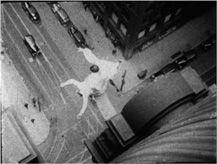
10.81 … and danger.
The next part of the segment begins with an apparent incongruity between music and image. A series of shots shows parts of a submarine, including an officer looking through a periscope (6.36). The next shot seems to suggest that he sees a bikini-clad woman (6.37). This shot picks up the stag film motif from
segment 1
and points out the paradox of this juxtaposition. We know the shots of the officer and the woman come from different films—yet, at the same time, we cannot help but interpret the shots as showing him looking at her, and thus we find the moment comic. As earlier parts of the film reminded us of endless credit sequences, perhaps this makes fun of point-of-view editing and the Kuleshov effect.
The same principle underlies the next shots, as the officer orders a torpedo fired, and we see it seeming to race toward the woman, creating a sexual pun. This, too, is funny, as is the atomic-bomb orgasm that seems to result. But, as in the first segment, there is an overtone of threat and aggression—now specifically sexual aggression—in these images. They move quickly from humor to disaster as additional mushroom cloud shots undercut the joke. Moreover, the music that plays through the submarine–woman series is slow, quiet, and ethereal—
not
appropriate to the erotic joke, but more suited to the images of the bomb blasts.
This music carries us into a series of shots of waves and wavelike movements that seem to result from the bomb: a ship engulfed by fog or smoke, surfers and rowing teams battered by heavy waves, water-skiers and motorboaters falling during stunts. During this, the music’s ethereal quality gives way to a slow melody with a dynamic tempo, played on low stringed instruments; this creates a more ominous tone. The first accidents seem trivial, as when water-skiers fall over. But gradually, things become more disturbing. A motorboat driver plows into a pile of debris and is hurled out.
Abruptly, people are seen riding odd bicycles
(
10.82
).
The move from the boat to the bikes takes us briefly away from the accident series to a string of shots showing people deliberately doing things that look grotesque. Additional shots show motorcyclists riding through mud and water, and a plane trying to land on a lake and flipping over.
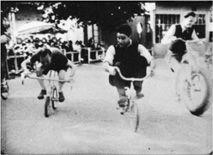
10.82 An inexplicably grotesque image from
A Movie.
The whole segment has developed steadily, introducing tension at the beginning and then juxtaposing the humorous (the submarine–woman scene) with the disastrous (the bomb) and trivial accidents with grotesque actions. The sequence ends in an odd way: black leader appears after the plane crash, with the music building up toward a climax. This is followed by a close view of Theodore Roosevelt speaking vigorously, seemingly angry, with bared teeth
(
10.83
).
Immediately, there follows a shot of a collapsing suspension bridge, with the music swelling up as the pieces fall
(
10.84
)
and then fading down. Although these shots are difficult to interpret, the association of human-caused disasters with one of America’s most belligerent presidents would seem to link even the toppling bridge to human, especially political, aggression.
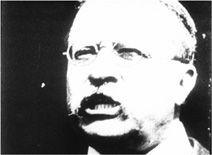
10.83 In this puzzling shot from
A Movie,
Roosevelt speaks vigorously, seemingly angry, with bared teeth.
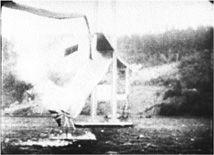
10.84 A collapsing bridge in
A Movie.
Once more
A Movie
marks off its segments clearly, with black leader again accompanying the opening of the third portion of
The Pines of Rome.
An eerie gong and low, slow chords create a distinctly ominous mood.
Segments 2
and
3
both built up toward accidents and disasters. Now
segment 4
begins with a series of images of military planes being shot out of the sky and firing on the ground, followed by a series of explosions against a dark sky.
Yet the next passage juxtaposes shots of disasters with some shots that are inexplicable in this context. All the images of planes and explosions seem associated with war and disaster. Now we see two planes flying past an Egyptian pyramid
(
10.85
).
As with so many of the earlier juxtapositions, we must abruptly switch our assumptions about how these shots relate to one another, since now we see nonmilitary planes. But immediately, two shots of an erupting volcano appear. Clearly, the connection between them and the previous shot is mainly created by the pictorial similarity of mountains and pyramids. Are we back to disasters again? Seemingly not, for we next see an elaborate church ceremony, and all our expectations are thwarted. But the disaster motif returns as strongly as ever: the burning dirigible
Hindenburg,
tanks, more race car crashes, and tumbling bodies.
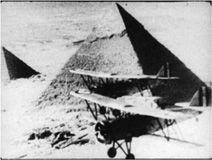
10.85
A Movie.
All these images create tension, but the next shots we see are of people parachuting from a plane. Interestingly, this action is not threatening, and the people here are not hurt. Yet in the context of the earlier accidents, and because of the ominous music, we have begun to expect some sort of disaster as the likeliest subject of each shot. Now even these innocent actions seem threatening and again may be seen as linked to military and political aggression.
The next series of shots is equally innocent in itself but takes on mysterious and ominous overtones as part of the overall segment. We see a burning balloon floating to earth, reminding us of the floating dirigible and
Hindenburg
footage. Shots of palm trees, cattle, and other images follow, suggesting some idyllic Middle Eastern or African setting
(
10.86
).
This brief respite, however, leads into one of the film’s eeriest and most striking moments: three shots of a suspension bridge writhing and buckling as if shaken by a giant hand
(
10.87
).
This is followed by the most intense disaster images in the whole film, including the burning
Hindenburg:
a sinking ship
(
10.88
),
a firing-squad execution, bodies hanging on a scaffold, dead soldiers, and a mushroom cloud. A shot of a dead elephant and hunters introduces a brief series of shots of suffering Africans. The music has built up during this, becoming steadily less ominous and more triumphant with fanfares of brass instruments.
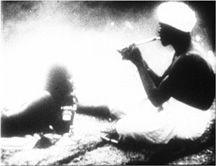
10.86 A brief moment of peace in
A Movie.
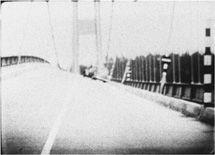
10.87
A Movie:
a frightening image of a buckling bridge.
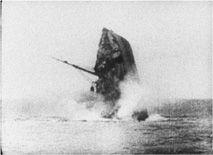
10.88
A Movie:
more disasters as a ship sinks.
